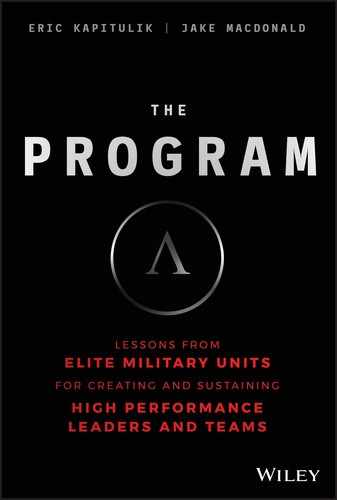1
The Fundamentals of a Championship Culture
THE SUN ROSE bright and clear over the Tora Bora Mountains in eastern Afghanistan on January 10, 2013, providing a surreal moment to remind them of the beauty the world can offer in the midst of a combat zone. The president of The Program Corporate, then U.S. Marine Corps Captain Cory Ross, was acting as a military adviser, attached to an Army Special Forces A-team. For months, Captain Ross had been operating with this team of Green Berets. He went everywhere they did and participated in all their operations, from meeting with village elders and providing medical services, to fighting alongside his Army teammates against Taliban forces. That morning, they accompanied some of the Afghan local police, men they had recruited and trained to protect their own villages, on a tour of their area. They bonded and built rapport with the Afghans throughout the morning. For lunch, the Afghans slaughtered a sheep, a sign of great respect, for the American forces. While they ate, though, Cory and his teammates began receiving radio reports of multiple military-age males moving toward the village. Cory and the Special Forces soldiers tightened security, but didn’t leave the village until lunch was finished, lest they insult their hosts. Typically, military units do not like to be predictable and will not use the same roads and paths, both to and from areas, that they are operating. However, the mountainous terrain offered no other options for Cory and his teammates. They had only one possible route back to their forward operating base. Although Cory was uncomfortable taking the same roads, the mood of the unit was still optimistic. The day was peaceful, and they were proud of the progress that they, and their Afghan counterparts, had made. That peace was completely shattered as they reached a hairpin turn in the road a short distance outside the village. To achieve success on any battlefield, at some point we must overcome adversity. Maybe not the same amount as that about to be experienced by Cory and his teammates at this hairpin turn in the road, but company cutbacks, bad calls by the referee, sick or injured players, a poor economy, or a host of other factors will challenge all of us. In those moments, despite that adversity, an organization’s culture will manifest itself in that team’s ability to still successfully accomplish its mission—or not. To achieve success on any battlefield, at some point we must overcome adversity. To ensure the former, a culture must first be defined by the leader’s Core Values and embodied by talented team members. Second, the organization’s best people must determine the goals and standards that daily reinforce those Core Values. It isn’t enough to say that we have a culture based on family, for example, unless we can prove it every day. Our goals—and more importantly, our standards—ensure we do so. Without them, like too many organizations, we don’t have a culture based on family. Instead, we have an organization that merely makes t-shirts for their company or posts “Family” signs in the lobby. To consistently accomplish the mission on whatever our chosen battlefield, organizations must have (1) the best people, (2) goals and standards, and finally, (3) a daily commitment to holding one another accountable for achieving them (Figure 1.1). Figure 1.1 Three Components of a Championship Culture

